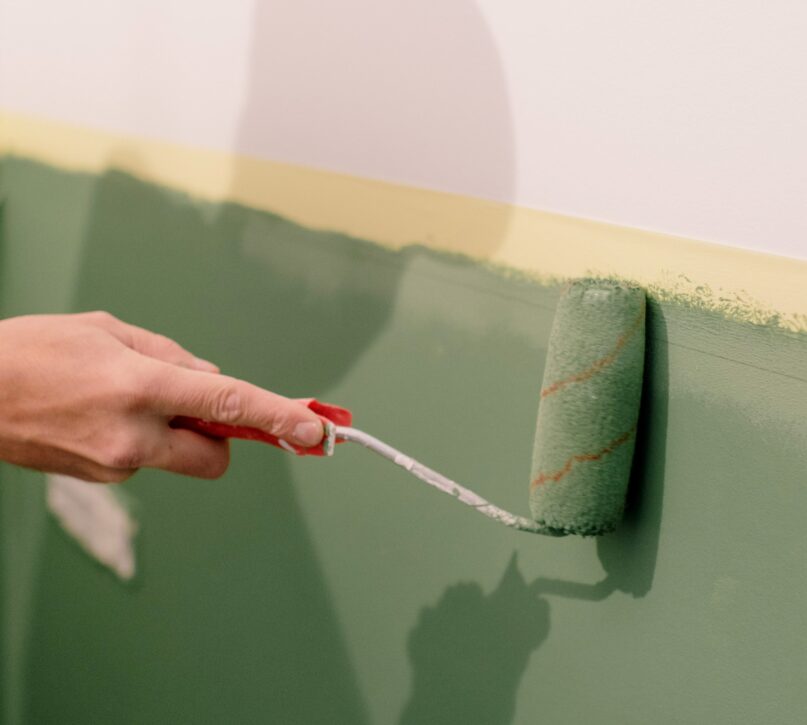Painting your home is one of the easiest and most cost-effective ways to update and transform your living space. Not only can a fresh coat of paint give your home a new look and feel, but it can also protect your walls from damage and wear and tear. Whether you’re looking to brighten up a room, add some personality to your home, or simply protect your walls, painting is an excellent solution.
In this article, we’ll explore the many benefits of painting your home, as well as provide tips and tricks on how to paint your home like a professional. So, grab a paintbrush and let’s get started!
Choosing the Right Paint
A. Types of paint available : When it comes to choosing the right paint for your home, there are a few different types to consider. Some of the most common types of paint include:
- Latex paint: This water-based paint is easy to clean up and dries quickly. It’s ideal for interior walls and ceilings and is available in a range of finishes, including flat, eggshell, satin, and high-gloss.
- Oil-based paint: This type of paint is more durable than latex paint and is ideal for high-traffic areas like kitchens and bathrooms. However, it takes longer to dry and can be difficult to clean up.
- Specialty paints: These include textured paint, metallic paint, and chalkboard paint. While they may not be suitable for every room in your home, they can add a unique touch to your space.
B. Factors to consider when selecting paint for your home
There are a few key factors to consider:
- Room function: The type of paint you choose will depend on the function of the room. For example, you may want a washable paint in a child’s bedroom or a mold-resistant paint in a bathroom.
- Lighting: The amount of natural light in a room can affect how paint colors appear. Consider the lighting in your space when selecting a paint color.
- Existing décor: The color of your furniture, flooring, and décor can influence the color of the paint you choose.
C. Tips on choosing the right paint for your home. To choose the right paint for your home, follow these tips:
- Consider the room function and lighting.
- Look at paint samples in the room you’ll be painting to get an accurate idea of how the color will look.
- Take note of the finish you want. Flat finishes are best for hiding imperfections, while high-gloss finishes are ideal for trim and accents.
- Test a small area of the wall with the paint color to see how it looks before committing to painting the entire room.
Preparing Your Home for Painting
Before you start painting your home, it’s important to properly prepare the surfaces to ensure a smooth and even finish. Here are some steps to follow when preparing your home for painting:
A. Cleaning and preparing the surfaces
- Remove any dirt, dust, or debris from the walls by using a damp cloth or sponge.
- Fill any cracks or holes in the walls with spackle and let it dry completely.
- Sand the walls to create a smooth surface for the paint to adhere to.
- Use painter’s tape to protect any areas you don’t want to paint, such as baseboards or door frames.
B. Covering and protecting your furniture and floors
- Remove any furniture or objects from the room, or cover them with plastic sheeting or drop cloths.
- Cover the floors with drop cloths to protect them from paint splatters and spills.
C. Removing hardware and fixtures
- Remove any hardware, such as door handles or light switch covers, from the walls.
- Cover any remaining fixtures, such as light fixtures or outlet covers, with painter’s tape.
By following these steps, you can ensure that your home is properly prepared for painting and that you will achieve a professional-looking finish.
Painting Techniques to Paint Your Home
Once you have prepared your home for painting, it’s time to start painting! Here are some painting techniques to help you achieve a professional-looking finish:
A. Brushing and rolling techniques
- Load your brush or roller with paint and apply it to the wall in smooth, even strokes.
- Use a “W” or “M” pattern to apply the paint, working in small sections at a time.
- Avoid overloading your brush or roller with too much paint, as this can result in drips and uneven coverage.
- Use a small brush to cut in around corners, trim, and other tight spaces.
B. Spraying techniques
- Use a paint sprayer to achieve a smooth, even finish on larger surfaces.
- Follow the manufacturer’s instructions for setting up and using the paint sprayer.
- Use a drop cloth to protect surrounding areas from overspray.
- Work in small sections at a time, overlapping each pass to ensure even coverage.
C. Tips on applying paint to achieve a professional finish
- Apply multiple thin coats of paint, rather than one thick coat, to avoid drips and achieve even coverage.
- Use a paint extender to help the paint go on smoothly and reduce brush marks.
- Work from top to bottom, starting with the ceiling and working your way down to the baseboards.
- Take breaks as needed to avoid fatigue, which can lead to uneven coverage.
By using these painting techniques, you can achieve a professional-looking finish on your walls and ensure that your home looks its best.
Color Schemes and Design to Paint Your Home
Choosing the right color scheme and design for your home can be a daunting task. Here are some tips to help you create a cohesive and visually appealing look for your home:
- Consider the mood you want to create: Different colors can evoke different emotions. For example, blues and greens can create a calming and peaceful environment, while yellows and oranges can create a more energetic and vibrant atmosphere.
- Look for inspiration: Browse home decor magazines, websites, and social media platforms like Pinterest and Instagram for ideas and inspiration. Take note of color schemes and designs that catch your eye and consider how they might work in your own space.
- Keep the style of your home in mind: The color scheme and design you choose should complement the style of your home. For example, if you have a traditional style home, you might want to choose classic colors like navy blue, deep red, or forest green. If you have a modern or minimalist style home, you might want to choose a more neutral color palette with pops of color.
- Choose a color scheme: Once you have a general idea of the mood and style you want to create, choose a color scheme that will work well in your space. There are several different color schemes to choose from, including monochromatic, complementary, analogous, and triadic.
- Test your colors: Before committing to a color scheme, test your colors in the room you plan to paint. Paint a small section of the wall or use a sample swatch to see how the colors look in different lighting conditions.
- Think about texture: Don’t forget about texture when choosing a color scheme and design. Consider adding different textures like wood, metal, and textiles to add depth and interest to your space.
- Don’t be afraid to ask for help: If you’re struggling to choose a color scheme or design, don’t be afraid to ask for help. Consider hiring a professional interior designer or color consultant who can help you choose the right colors and create a cohesive look for your home.
Maintaining Your Newly Painted Home
After painting your home, it’s important to take proper care of your newly painted surfaces to ensure they stay looking fresh and vibrant for years to come. Here are some tips for maintaining your newly painted home:
- Wait for the paint to dry completely: It’s important to wait for the paint to dry completely before cleaning or touching the painted surface. The drying time can vary depending on the type of paint used and the environmental conditions.
- Clean regularly: Regular cleaning helps to prevent dirt and grime from building up on the painted surface. Use a soft cloth or sponge with mild soap and water to clean the painted surface.
- Avoid harsh chemicals: Harsh chemicals can damage the painted surface and cause the paint to peel or fade. Avoid using harsh chemicals or abrasive cleaners on your newly painted surfaces.
- Use touch-up paint: Over time, your painted surfaces may become scuffed or scratched. Keep a small amount of touch-up paint on hand to fix any minor imperfections.
- Protect the painted surface: Protect the painted surface from damage by using protective coverings, such as furniture pads, to prevent scratches or dents.
- Keep the area well-ventilated: Proper ventilation is important during the painting process and also after the paint has dried. Keeping the area well-ventilated helps to prevent the buildup of harmful fumes and odors.
- Schedule regular maintenance: Schedule regular maintenance to check for any signs of damage or wear and tear. This will help you catch any issues early on and prevent them from becoming larger problems.
FAQ Section
The type of paint you should use depends on the surface you are painting and the room you are painting. For example, you might want to use a different type of paint for a bathroom than you would for a living room. It’s important to choose a high-quality paint that is appropriate for the surface you are painting.
Yes, you can paint over old paint, but it’s important to properly prep the surface before painting. This includes cleaning the surface, repairing any damage, and sanding to create a smooth and even surface.
The number of coats of paint you need to apply depends on the type of paint and the surface you are painting. In most cases, two coats of paint are sufficient to achieve a smooth and even finish.
It depends on your level of experience and the complexity of the job. If you have experience painting and feel confident in your abilities, you can certainly paint your home yourself. However, if you have a large or complex project, or you’re not comfortable with painting, it might be best to hire a professional painter.
After painting, it’s important to properly clean up your tools and workspace. This includes cleaning brushes and rollers with soap and water, disposing of paint cans and other materials properly, and wiping down surfaces with a damp cloth to remove any paint drips or spills.
Final Tips and Tricks to Paint Your Home
Here are some final tips and tricks to keep in mind when painting your home:
- Prep the surface: Proper surface preparation is key to achieving a smooth and long-lasting paint job. This includes cleaning the surface, repairing any cracks or holes, and sanding to create a smooth and even surface.
- Use high-quality tools and materials: High-quality paint, brushes, rollers, and other tools will help to ensure a professional-looking finish. Cheap materials can result in a poor-quality paint job that won’t last.
- Use primer: Primer helps to create a smooth and even surface and helps the paint adhere better to the surface. It also helps to cover up any stains or dark colors, which can save you time and money in the long run.
- Work in sections: Working in small sections helps to prevent the paint from drying too quickly and allows you to achieve a consistent finish.
- Don’t rush: Painting can be time-consuming, but it’s important to take your time and not rush the process. Rushing can result in mistakes or an uneven finish.
- Keep the room well-ventilated: Proper ventilation is important during the painting process to prevent the buildup of fumes and odors.
- Clean up properly: Properly cleaning up after painting helps to prolong the life of your tools and ensures a tidy workspace for future projects.
By following these tips and tricks, you can achieve a beautiful and long-lasting paint job for your home.





